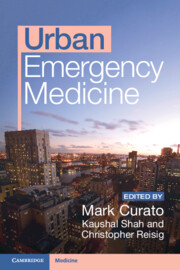Book contents
- Urban Emergency Medicine
- Urban Emergency Medicine
- Copyright page
- Contents
- Contributors
- Preface
- Chapter 1 Caring for the Homeless
- Chapter 2 Disruptive and Dangerous Agitation
- Chapter 3 Penetrating Trauma
- Chapter 4 Substance Use
- Chapter 5 Human Trafficking
- Chapter 6 Travelers from Overseas
- Chapter 7 HIV, AIDS, and Tuberculosis
- Chapter 8 Asthma
- Chapter 9 Physician/Patient Discordance
- Chapter 10 LGBTQIA+ Care
- Chapter 11 Child Maltreatment
- Chapter 12 Care of Vulnerable Elders
- Chapter 13 Civil Unrest: Caring for Police and Protesters
- Chapter 14 Terrorism and Mass Casualty Incidents
- Chapter 15 Overcrowding, Triage, and Care Rationing
- Index
- References
Chapter 14 - Terrorism and Mass Casualty Incidents
Published online by Cambridge University Press: 20 July 2023
- Urban Emergency Medicine
- Urban Emergency Medicine
- Copyright page
- Contents
- Contributors
- Preface
- Chapter 1 Caring for the Homeless
- Chapter 2 Disruptive and Dangerous Agitation
- Chapter 3 Penetrating Trauma
- Chapter 4 Substance Use
- Chapter 5 Human Trafficking
- Chapter 6 Travelers from Overseas
- Chapter 7 HIV, AIDS, and Tuberculosis
- Chapter 8 Asthma
- Chapter 9 Physician/Patient Discordance
- Chapter 10 LGBTQIA+ Care
- Chapter 11 Child Maltreatment
- Chapter 12 Care of Vulnerable Elders
- Chapter 13 Civil Unrest: Caring for Police and Protesters
- Chapter 14 Terrorism and Mass Casualty Incidents
- Chapter 15 Overcrowding, Triage, and Care Rationing
- Index
- References
Summary
Terrorism and mass casualty incidents are considered low-frequency, high-impact events and while medical professionals have always responded and cared for victims of such events, there is an increasing need for healthcare systems to be proactive in preparing, mitigating, and responding to these increasingly complex and devastating incidents. Counter-terrorism medicine is a subspecialist disaster medicine field that aims to address the healthcare impacts of intentional, man-made attacks and the unique challenges medical professionals and healthcare systems face before, during and after a terrorist event. Mass casualty incidents are challenging, terrorist attacks are complex, and the day-to-day demands on healthcare systems around the world have never been higher. Although rare, a terrorism event has the potential to exploit all these vulnerabilities to create a black swan event and healthcare professionals need to collaborate with their intelligence, security, law enforcement and other emergency services counterparts to mitigate the risks of a potential devastating man-made disaster.
Keywords
- Type
- Chapter
- Information
- Urban Emergency Medicine , pp. 173 - 183Publisher: Cambridge University PressPrint publication year: 2023

